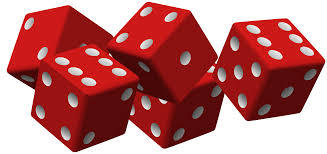Yahtzee!

You roll five six sided dice, but don't look at the results.
At least four of the five were fours.
The probability you rolled five fours is b a , where a and b are coprime posiitve integers. What is a + b ?
Image credit: http://www.clipartkid.com/
The answer is 27.
This section requires Javascript.
You are seeing this because something didn't load right. We suggest you, (a) try
refreshing the page, (b) enabling javascript if it is disabled on your browser and,
finally, (c)
loading the
non-javascript version of this page
. We're sorry about the hassle.
2 solutions
A=throw at least 4 Times 4 with 5 dice. B=throw 5 Times a 4 with 5 dice. P(A)=5/6 (1/6)^4 Comb(1 out of 5)+(1/6)^5 P(B)=(1/6)^5 P(A|B)=1 P(B|A)=P(B)*P(A|B)/P(A)=1/(25+1)=1/26
Nice question but I misunderstood it by ignoring what "someone" told me---seemed unreliable info. Maybe better to simply state that "At least four of the five were fours".
Rolling dice is an example of a Binomial Distribution .
As such, the probability of rolling 4 fours is P r ( 4 f o u r s ) = ( 4 5 ) ∗ ( 1 / 6 ) 4 ∗ ( 5 / 6 ) 1 = 7 7 7 6 2 5 . (Intentionally Unsimplified)
The probability of rolling 5 fours is P r ( 5 f o u r s ) = ( 5 5 ) ∗ ( 1 / 6 ) 5 ∗ ( 5 / 6 ) 0 = 7 7 7 6 1 .
P r ( ≥ 4 f o u r s ) = P r ( 4 f o u r s ) + P r ( 5 f o u r s ) = 7 7 7 6 2 6 .
P r ( ≥ 4 f o u r s ∩ 5 f o u r s ) = P r ( 5 f o u r s ) , as ≥ 4 f o u r s ⊇ 5 f o u r s .
As such P r ( 5 f o u r s ∣ ≥ 4 f o u r s ) = P r ( ≥ 4 f o u r s ) P r ( 5 f o u r s ) = 2 6 1 .
1 + 2 6 = 2 7
There are 2 6 ways you could have rolled the dice:
Only one has 5 fours. So the probability is 2 6 1 .
1 + 2 6 = 2 7